Project Updates
AFTER SEVEN MONTHS:Main Achievements
Major Scientific Breakthroughs
AFTER 19 MONTHS:
Main Achievements
Major
Scientific Breakthroughs
Main achievements
Major Scientific Breakhroughs

1. Samplings and characterisation of the microbial mat samples
In the Larsemann Hills, benthic microbial mats were collected by BAS
from 70 lakes (austral summer 97) on a transect from the Bolingen Islands
to the Vestfold Hills (Larsemann Hills and offshore Islands and the Rauer
Islands). Physico-chemical characterisation of the lake water was carried
out. Lakes were selected to cover a wide range of chemical environments
(pH ranging from 5.5 to 9.4, salinity from 0.01 to 31 %, conductivity from
0.04 to 131.5 mS/cm). Lake Reid has been selected as the reference site
for which the partners will undertake to give a whole picture of biodiversity.
The samples were put at the disposal of the project in November 99. In
the Dry Valleys, samples from lake Fryxell (reference site) and lake Hoare
were collected (austral autumn 99) by American colleagues of the LTER program
of NSF and reached the partners in February 99. In the Vestfold Hills,
samples from lakes Druzby, Organic, Ace (reference site), Pendant, Watts,
and Grace were collected by U-Nottingham (austral autumn 99) and sent to
the partners in May 99.
2. Cultivated microbial biodiversity
For bacteria, samples were homogenised and plated on different media,
incubated at several temperatures. For other microorganisms where the morphology
can be useful for identification (cyanobacteria, protists, fungi), subsamples
were fixed for microscopic observations. Other subsamples were plated out
on a variety of solid media, diluted or enriched in liquid culture. In
addition to classical recipes, new media were designed to better match
the natural conditions. Different temperatures were used for the incubations,
to recover both psychrophiles and psychrotrophs. Moreover, the Benthic
Gradient Chamber has started to be used with various gradients (H2S, O2,
light) at 5°C to serve as enrichment culture and to try to maintain
the mats in vivo.
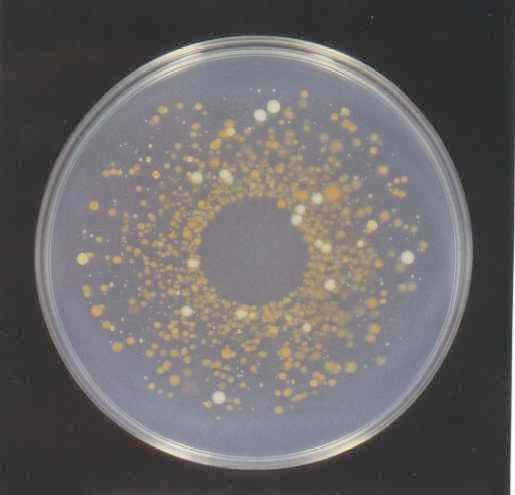 |
Preliminary results show that the level of diversity is different for each group of microorganisms. In the case of bacteria, a single mat sample yields several hundreds of putatively different colony types. For cyanobacteria, fungi and photosynthetic and heterotrophic protists, a high diversity can only be achieved by studying a wide range of lakes with different environmental conditions (salinity, pH,...). Isolation of pure strains is currently being carried out. |
B. MAJOR SCIENTIFIC BREAKTHROUGHS
1. Physico-chemical and geological diversity of the lakes
The seemingly monotonous landscape of ice-free Antarctica conceals
a great variation of lake characteristics. Thanks to the extensive survey
made in the Larsemann Hills (70 lakes), we can already observe that the
populations of cyanobacterial and algae are very diverse, and reflect the
ecosystem diversity in terms of salinity, pH, and physico-chemistry. The
few samples from Vestfold Hills and the Dry Valleys broaden this biodiversity,
especially the Dry Valleys' lakes which are older and quite separated geographically
from the two other locations. In the studied Antarctic lakes, the plankton
has low species diversity, in contrast to the microbial mats which harbour
a great diversity of microorganisms and show differences between lakes.
| 2. The use of the Benthic Gradient Chamber
The Benthic Gradient Chamber, a novel cultivation device mimicking natural gradients, has been successfully adapted to function at 5 °C, but media composition needs to be improved for enriching communities that are more similar to the natural source material. |
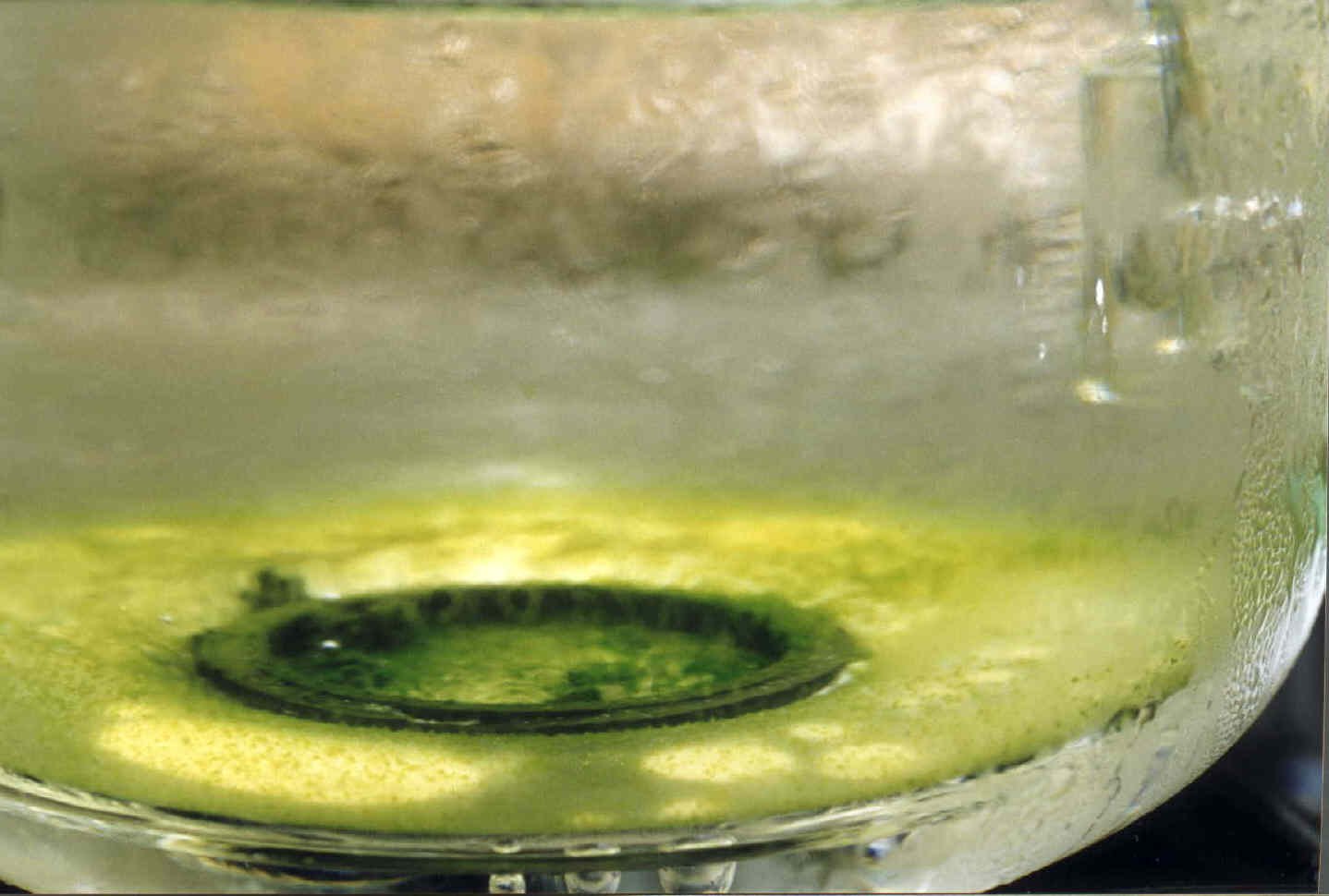 |
The bacterial biodiversity, based on colony and cultivation characteristics, seems very high in the sample from Lake Fryxell (600 and 200 isolates found by DSMZ and RUG, respectively). It is quite surprising that the majority of the colonies are coloured, indicating a high carotenoid content for most strains. A very low number of obligate anaerobes was isolated from the mat samples. Another unexpected observation was that a mineral medium yielded organisms able to use the impurities in the agar as organic nutrients.
Isolation of fungi and yeasts from 24 samples has yielded until now
200 isolates. All of them appeared able to grow above 20°C and are
thus not true psychrophiles. For the cyanobacteria, a high morphological
diversity is observed (30 taxa) under the microscope when mats from the
Larsemann Hills' lakes are observed. Many of them have very dark-coloured
sheaths. The presence of the genera Coleodesmium and Petalonema, observed
in 1 or 2 lakes of the Larsemann Hills, had never been recorded in Antarctica
previously.
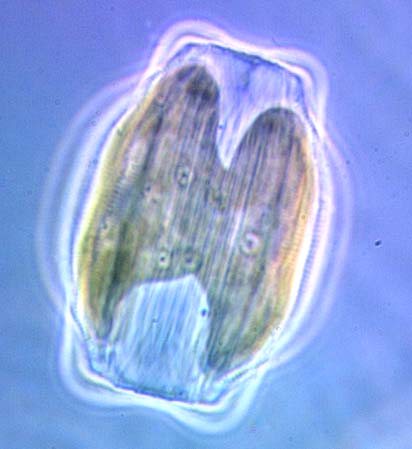 |
In the case of photosynthetic protists, desmids of the genus Cosmarium appeared abundant. For the Bacillariophyceae (diatoms), one unexpected finding is that lakes which are emerging from under the ice sheet for the first time in 1000's of years, due to deglaciation, contain a divergent flora from those lakes which have been exposed for longer periods of time. In addition, it is also observed that many teratological (abnormal) forms are observed in the diatoms. Cultivation in Petri plates filled with liquid medium (for algal growth) seems to allow formation of a mat-like structure with quite a variety of microorganisms, including nematodes, rotifers, fungi, etc. |
4. Biodiversity of pigments and relations to the light climate
 |
One of the early findings of the pigment analyses is that the cyanobacteria from the Larsemann Hills contain a great abundance of carotenoids and other screening pigments. This corresponds to the observation that the sheaths of many cyanobacteria are dark-coloured under the microscope. In contrast the chlorophylls, which are used in photosynthesis, are in low abundance. It would appear that these organisms are well adapted to survive and photosynthesise using the very small quantities of light available through the Antarctic spring and autumn. Conversely, during the Antarctic summer, there is so much light that the major effort is one of heat dissipation and protection rather than photosynthesis. This is carried out using xanthophylls which disperse excess energy (heat) from the cells using the xanthophyll cycle and by a number of carotenoid-like pigments which are directly responsible for UVB protection. |
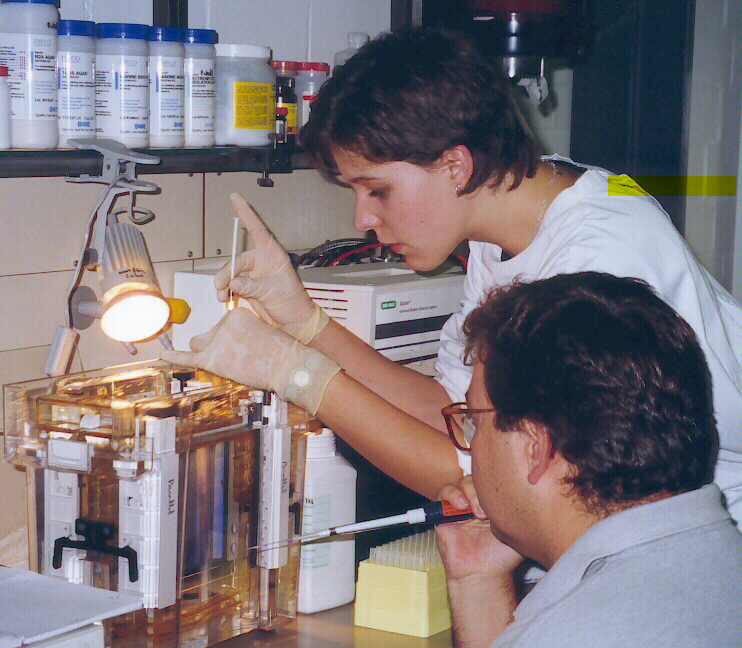 |
From 11 to 14 October 1999, a workshop on DNA isolation
from microbial mats was organised by DSMZ (Dr. Brian Tindall and Erko Stackebrandt).
Participants: Evelyne Brambilla (DSMZ)
|
Pictures
The Workshop team
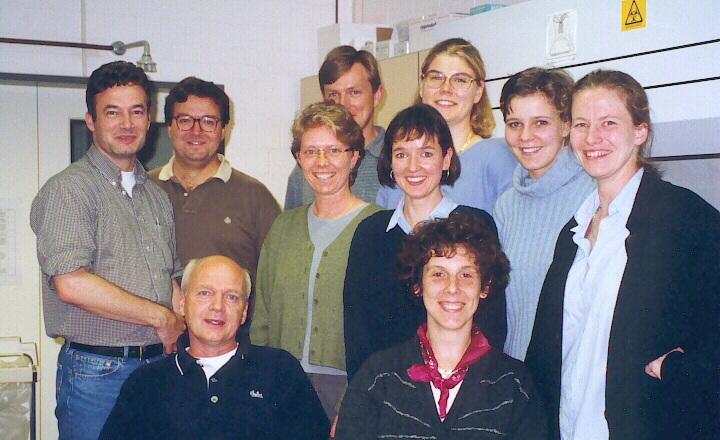
Starting the extractions
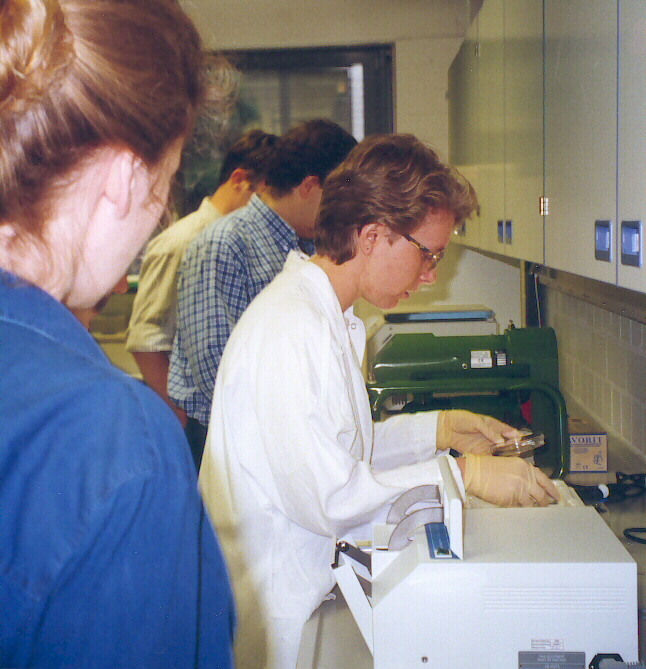 |
Phenol extractions after bead-beating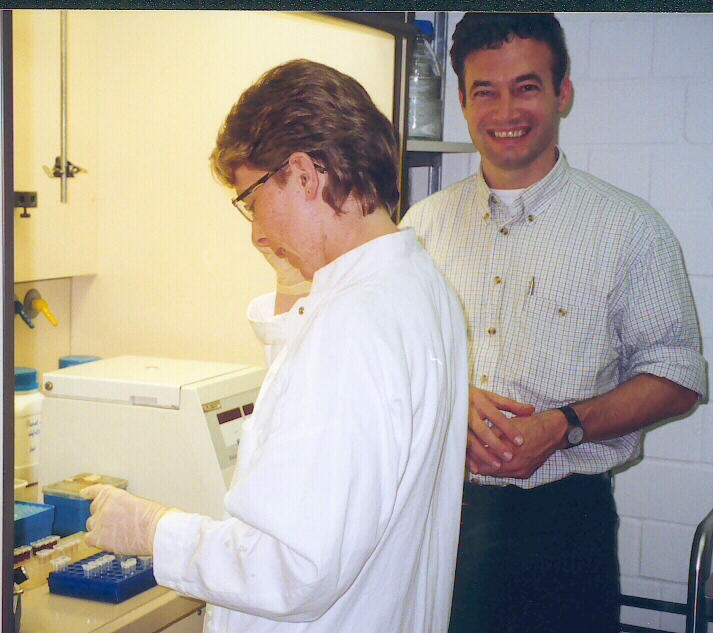 |
Example of agarose gel electrophoresis result
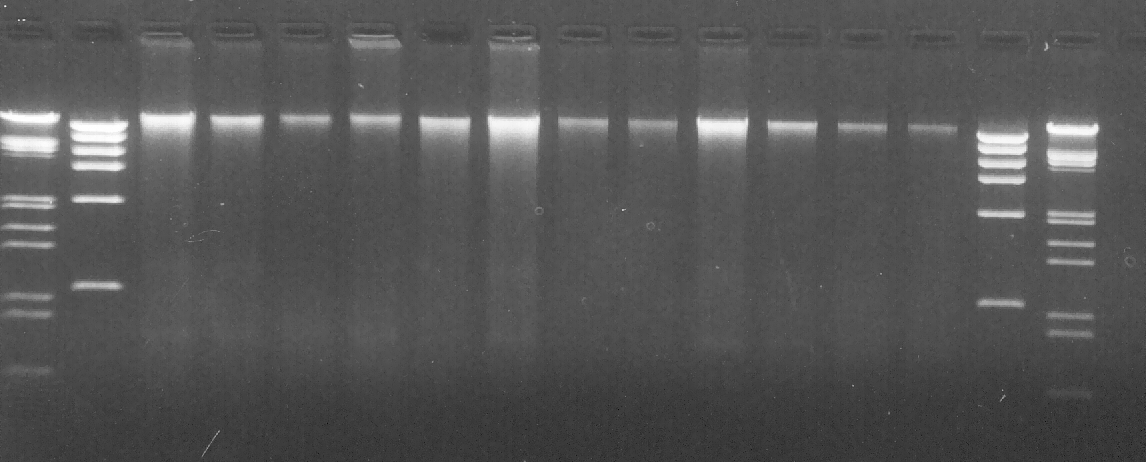

Samplings and characterisation of the microbial mat samples
Additional sampling was carried out by the partners of the University
of Nottingham in the Vestfold Hills and Larsemann Hills during the Austral
Summer of 1999-2000. The physico-chemical characterisations were carried
out. Overall, in Antarctic lakes, the cyanobacterial and protist biodiversity
in the mats appears higher than in the plankton when observed by light
microscopy.
Adaptation of the organisms to high UV irradiation was observed in shallow lakes as shown by the abundance of mycosporine-like amino acids, scytonemin, and carotenoids, and by the low chlorophyll content.
Cultivated microbial biodiversity
Using the BGC (Benthic Gradient Chamber), artificial mat communities
adapted to grow at 5°C in opposing oxygen-sulfide gradients were obtained
and studied with microsensors. More than one thousand bacterial colonies
from 16 mat samples have been isolated and characterised, either by fatty
acid analysis and 16S rDNA, or by FT-IR (Fourrier Transform Infra Red)
and 16S rDNA. They have been preserved in liquid nitrogen. Heterotrophic
bacterial isolates from Lake Fryxell and Ace Lake are very different. Hundreds
of cyanobacteria, fungi, and eukaryotic protists were obtained from 3 to
20 lakes and are being characterised phenotypically and genotypically.
About half of all these strains were made available for screening.
"Yet to be" cultivated microbial biodiversity
A DNA extraction workshop was organised in October 99 in DSMZ. The
extracted DNA from Lake Fryxell and Ace Lake was made available to the
partners. Clone libraries of SSU rDNA from Ace Lake and Lake Fryxell were
obtained with PCR primers specific for bacteria (only Lake Fryxell), cyanobacteria,
protists and eukaryotes. The 45 cyanobacterial clone sequences from Lake
Fryxell and Ace Lake are very different.
DGGE and TGGE methods were optimised for different taxonomic groups
(bacteria, cyanobacteria, algae and protozoans) and these analyses are
currently underway.
Screening of microbial biodiversity
The extra-cellular hydrolytic activity of the bacterial isolates screened
so far is surprisingly low. This may imply that the strains brought into
culture utilize low molecular weight substrates rather than proteins and
polymeric carbohydrates. This hypothesis is presently tested by APIZym
screening. For antimicrobial activity screening of bacteria, the preliminary
study of microfermentations was necessary due to dissimilar growth patterns
and in many cases slow growth rates. In contrast, the fungal isolates give
good biomasses in all media at 20°C. In the first group of bacterial
strains screened so far from Lake Fryxell, few antimicrobial activities
were detected.
MAJOR SCIENTIFIC BREAKTHROUGHS
Observed and cultivated microbial biodiversity
Photosynthesis and respiration in the artificial mats cultured in the
BGC are optimal between 5-10°C, showing a good adaptation to the environment.
Overall, the diversity of microorganisms in our samples of lake mats is
surprisingly high !. There are also important differences in diversity
and composition of the heterotrophic bacterial flora of different lakes
(for example, Lake Fryxell and Ace Lake). This observation of a high biodiversity
among the members of the Bacteria is supported by the numerical analysis
of fatty acid compositions of several hundreds of bacterial heterotrophs,
by the FT-IR data on more than 800 bacterial strains, and by the first
16S rDNA sequences which cover five phyla and even revealed the existence
of several new taxa. This contrasts with the restricted diversity of members
of the Archaea in Lake Fryxell. The diversity of cyanobacterial genera
recorded (19) seems also quite high.
The distribution of diatom taxa in Larseman and Vestfold Hills lakes appears to be mainly governed by salinity and habitat characteristics. In the sediment cores from the three studied lakes, diatom species composition showed some distinct changes corresponding to historic marine/brackish and freshwater conditions. For the fungi, the psychrophilic ascomycete Thelebolus has been isolated from many lakes, as have been yeasts and to a certain exent, Hyphozyma-like fungi. For all groups, a minority of cultivated organisms shows a psychrophilic behaviour.
The widespread occurrence of the same protozoan genera such as Euplotes, Halteria and olotricha/Plagiocampa in algal mats across the Antarctic Continent is a breakthrough. The high incidence of amoeba is also interesting. One surprise was the discovery of a possible new species of Tetramitus in one lake. A related species was found in a nearby marine bay, so it looks as if the lakes may provide conditions which force the evolution of new species.
Although a wide range of prokaryotes and unicellular eukaryotes have already been isolated from a diverse range of aquatic habitats in the Antarctic, the results collected within the present project indicate that the microbial mats are particularly rich and diverse, more than would be expected for an 'extreme' environment.
"Yet to be" cultivated microbial biodiversity
While cultivated bacteria are closely related to described species,
sequences of environmental clones, retrieved directly from the environment,
indicate the presence of significantly less related organisms. Moreover,
many organisms are related to ones that have been isolated from antarctic
environments before. 45 cyanobacterial rDNA phylotypes are observed in
Lake Fryxell and Ace Lake, but none of them is common to both lakes.
A DGGE analysis of 15 lakes from the Larseman Hills shows that there
are large differences in eukaryotic genetic diversity between many lakes.
However, some lakes have very similar DGGE banding patterns. The cyanobacterial
DGGE patterns for Lake Fryxell and Ace Lake show a different diversity
in these two lakes.
SUMMARY OF THE FINAL REPORT
OBJECTIVES:
In order to assess and improve the characterisation of the cultivated
and ‘yet-to-be’ cultivated diversity of the bacteria, protists and fungi
in the mats of Antarctic lakes and to test this biodiversity for its novelty
and potential biotechnological use, two objectives were pursued during
this EC Biotech project:
1. The biodiversity of mat communities from diverse freshwater and saline lakes was studied. A comprehensive biological sampling of lakes in the Larsemann Hills was carried out to study present and past biodiversity by analysis of fossil pigments and diatoms. For the cultivated biodiversity, classical and novel isolation methods were used. Phenotypic and genotypic characteristics of the strains were determined. Modern molecular strategies, based on the SSU rDNA were used for genotypic characterisation of all types of microorganisms, in order to establish a standard taxonomic approach. The diversity of pigments and light-protective compounds were assessed. In parallel to the isolation of strains, the ‘yet to be’ cultivated biodiversity of all groups was estimated for samples of 3 reference lakes from the three studied regions (Dry Valleys, Larsemann Hills, Vestfold Hills) using molecular approaches based on rDNA sequences and involving clone libraries and DGGE-like techniques.
2. Isolated strains of bacteria, fungi and protists were screened for novel cold-tolerant enzymes and bioactive compounds. The purpose was to select hits with interesting antimicrobial activities and further exploit their chemical diversity with the aim to patent new potentially valuable antiinfective molecules or enzymes.
MAIN ACHIEVEMENTS OF THE PROJECT:
1) Sample characterisations
Partners 2 (BAS) and 3 (U. Nott) have obtained the samples which were
studied in this project. They have characterised the lake water composition.
A large variety of ecological conditions were provided by the sampled lakes
(depth, ice cover, salinity, pH, etc).
Chlorophylls, bacteriochlorophylls and carotenoids have been characterized
in 70 lakes and 13 sediment cores. These include screening pigments such
as scytonemin, and xanthophyll carotenoids. Other photoprotective pigments,
such as MAAs and Phycobiliproteins (Phycocyanin-like) were identified
in some lake surface sediments, but were absent from sediment cores (Reid
Lake).
Two artificial mats, obtained in a Benthic Gradient Chamber by partner
7 (U.Bordeaux), allowed an ecological study by microprobes and pigment
studies that show that the community was adapted to 5-10°C.Partners
1 (Ulg) and 4B (RUG) completed the study by a molecular diversity assesment.
2) Microscopic and cultivated microbial biodiversity
A data set on distribution of diatom taxa from 109 lakes of the Larseman
and Vestfold Hills and Dry Valleys (in cooperation with D. Roberts, Antarctic
CRC, Hobart, Tasmania) was obtained, as well as sediment core data on distribution
of fossil diatom taxa from Lake Reid, Pup Lagoon, Heart Lake owing to collaboration
of partners 2 (BAS) and 4B (RUG).
The isolated bacterial diversity, about 1500 strains from 9 lakes,
was studied by phenotypic, chemotaxonomic and molecular characterisation.They
are kept in liquid nitrogen by partners 4A (RUG) and 5 (DSMZ), and were
shared with the 3 industrial partners.
60 cyanobacterial strains from 24 lakes, 230 fungal strains from 17
lakes, 91 algal strains from 3 lakes, and 50 protozoans from 6 lakes were
obtained and characterised. Cyanobacterial and algal strains were distributed
to industrial partner 6 (Biosearch).
3) "Yet to be" cultivated microbial biodiversity
Lake Reid, Lake Fryxell and Ace Lake were chosen as the reference lakes
for the three Antarctic regions studied (Larsemann Hills, Dry Valleys,
Vestfold Hills).
Clone libraries of SSU rDNA for these 3 lakes were obtained with PCR
primers specific for bacteria (only Lake Fryxell), cyanobacteria, fungi
(only Lake Fryxell) and eukaryotes. The partners 3 (Unott) and 4B (RUG)
joined forces and complemented each other.
For bacteria, the most complete dataset of clone sequences (320) obtained
from a single mat sample in an Antarctic lake was obtained. In concert
with the taxonomic affiliation of cultured strains it has thus been possible
to obtain an overview of the food-web within the mat, ranging from aerobes
to anaerobes, from primary producers to degraders.
DGGE methods were optimised for different taxonomic groups (bacteria,
cyanobacteria, algae, fungi and protozoans). For eukaryotes, suitable primers
were lacking, resulting in retrieval of undesired sequences from tardigrades,
metazoans, etc. Partners 3 (U.Nott) and 4B (RUG) cooperated extensively.
For cyanobacteria, 153 16S rDNA sequences were obtained and revealed
potentially novel phylotypes, some of which were restricted to Antarctica.
For eukaryotes (fungi, protists, protozoans), about 300 18S rDNA sequences
of eukaryotes, 14 of fungi, were retrieved from 5 lakes and sequencing
is still in progress.
4) Screening of microbial biodiversity
The 3 industrial partners have increased their resource collections
with Antarctic strains and optimised cultivation and screening conditions
for their particular needs. A new technology was introduced by one partner
to automate the screening and was an unexpected achievement.
During the screening for cold enzymes, examples of all enzyme activities
(esterases, cellulases, levansucrases, proteases, amylase, lipase) screened
for have been found among the 1758 strains tested, although the relative
numbers having extra-cellular hydrolytic activity is surprisingly low.
For the antimicrobial compounds, more than 1700 bacterial and fungal strains
of diverse taxonomy and ecology were screened in a variety of conditions
by two industrial partners to ensure the best exploitation of their microbial
metabolic diversity. A total of 10,000 extracts were tested on a
panel of a dozen pathogenic bacterial and fungal strains in the search
of new antimicrobial activities. Cytotoxicity was also tested.
Besides, methods for cultivation, maintenance and HTS sample
preparation have been developed for cyanobacteria and photosynthetic protists.
40 cyanobacteria and 8 protists have been introduced in the culture collections
of 2 industrial partners. 2 hits have been selected and further exploitation
is ongoing according to the CA.
1) Paleolimnological analyses of LH lakes
Palaeolimnological analyses of cores from the Larsemann Hills have
revealed distinct fluctuations in diatom species composition and pigment
data during the last 40.000 years. These appear to be related to changes
in the lake environments caused by isosatic and climatic phenomena and
sea level changes. Results of 210Pb, 137Cs, 14C and 238U dating of the
sediments (financed by partner 2) indicates that the sediments in the Larsemann
Hills date back to beyond 40,000 years. We have therefore generated a uniquely
long record of past changes in biodiversity and environmental change in
Antarctic lakes. In some cases this starts at the time of colonisation,
spans the last glaciation and continues to the present day.
2) Observed and cultivated microbial biodiversity
Contrasting observations are obtained when considering either prokaryotic
or eukaryotic diversities. The prokaryotes (bacteria and cyanobacteria)
appear abundant and diverse, whereas the eukaryotic diversity is more restricted
than in less extreme environments.
Use of chemotaxonomic and molecular tools showed a large genomic diversity,
even within apparently coherent clusters. The highest bacterial genomic
polymorphism was observed with rep-PCR fingerprinting (partner 4A, RUG)
and Fourier-transformed Infrared Spectroscopy (partner 5, DSMZ). The latter
method appears as a promising innovative tool to screen rapidly and cheaply
isolates.
16S rDNA sequences also show that very few prokaryotes are identical
or related above 98% with sequences in the databases, and thus might be
either novel organisms or organisms for which no sequence data is existing
yet. This supports the hypothesis that the lake environments select for
cold adapted organisms which evolved differently from their ancestors for
an undefined time period.
For fungal diversity, a distinction could be drawn between the cold-adapted
taxa and the contaminants that probably came from other biotopes and were
entrapped in ice.
Although diversity is still incompletely known, it is possibly to state
that on average diversity of eukaryotic organisms in these systems is lower
than at lower latitudes. Fungal populations seem to be dominated by a few
well adapted species, as seems the case for the protozoans (top of the
microbial chain food). A comparison with algal communities from maritime
Antarctica almost immediately reveals that certain conspicuous algal taxa
are lacking from the MICROMAT sites. An additional problem for protozoan
strains is that their cultivation is difficult, and complex media or bacterial
cultures must be used. Noteworthy is that a new species of the flagellate
genus Tetramitus was found in Lake Fryxell, and has a marine relative in
Antarctic seaweater.
3) "Yet to be" cultivated microbial biodiversity
The “yet to be” cultivated cyanobacterial diversity in 3 lakes revealed
by molecular tools matches quite well with the isolates. Several strains
fall within clusters of phylotypes and give a putative identification to
these clusters.
For all other organisms, there was a striking difference between cultivated
and ‘yet to be’ cultivated eukaryotic diversity.
For bacteria, the analysis by clone library has revealed that most
amplified organisms had affinities to anaerobic taxa, whereas the sampling
and isolation conditions selected for aerobic strains.
Such a discrepancy can be observed for the fungi, though the information
obtained from the molecular tools is not so extensive. There is also a
striking difference between the cultivable and ‘yet-to-be’ cultivated eukaryotic
diversity in the 3 reference lakes. Sequence analysis of clone libraries
show that the dominant eukaryotes are autotrophic protists. DGGE analysis
of 15 lakes from the Larseman Hills shows that there are generally large
differences in eukaryotic genetic diversity between many lakes.Different
sets of autotrophic protists were found in each clone library according
to the salinity of the lake, with the more saline lakes (Pendent/Ace) dominated
by different species than those found in the near freshwater lake (Highway)
4). Screening of microbial biodiversity
Bacteria and fungi isolated in Antartic mats grow very well in standard
cultivation conditions and they can be considered psychrotolerant and not
psychrophilic. The frequency of antimicrobial activity is surprisingly
high and comparable with the one observed in isolates from more common
soil samples. The biomass productivity from Antarctic cyanobacteria
and microalgae had to be optimised. The inability of the organism
to adapt to high light intensity and to grow with air bubbling limits considerably
the productivity.Their screening shows an interesting pattern of
microbiological activities, but also the expected high frequency of citotoxic
activities. Biosearch continues the screenings.
With the screening of one of the industrial partners, up to 10% of the strains have shown some weak antimicrobial activity. Two bacterial strains from lakes Fryxell and Hoare have shown a potent activity against Gram positive pathogens, due to a cyclic thiazolyl peptide antibiotic. Two fungal strains produce an activity against Pseudomonas aeruginosa that will be further studied.
During the screening for cold enzymes, examples of all enzyme activities
screened for have been found, although the relative numbers having extra-cellular
hydrolytic activity is surprisingly low. Extra-cellular enzyme activity
data has been combined with taxonomic data to characterise the phenotypic
clusters. The data has been combined with ecological data to provide an
‘activity profile’ of the individual lakes.
